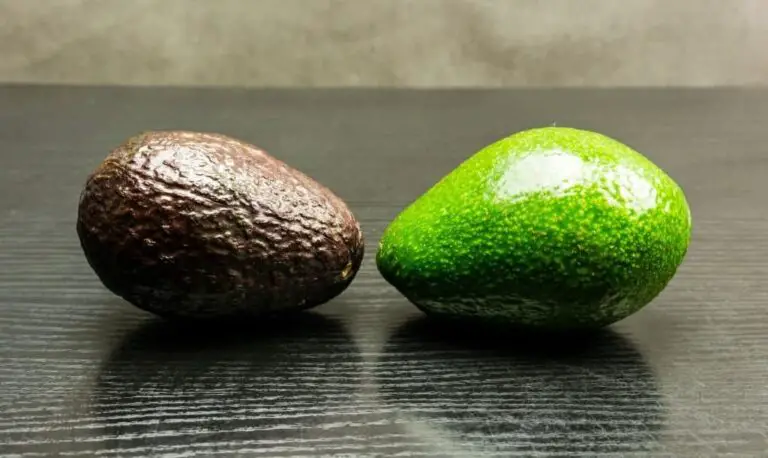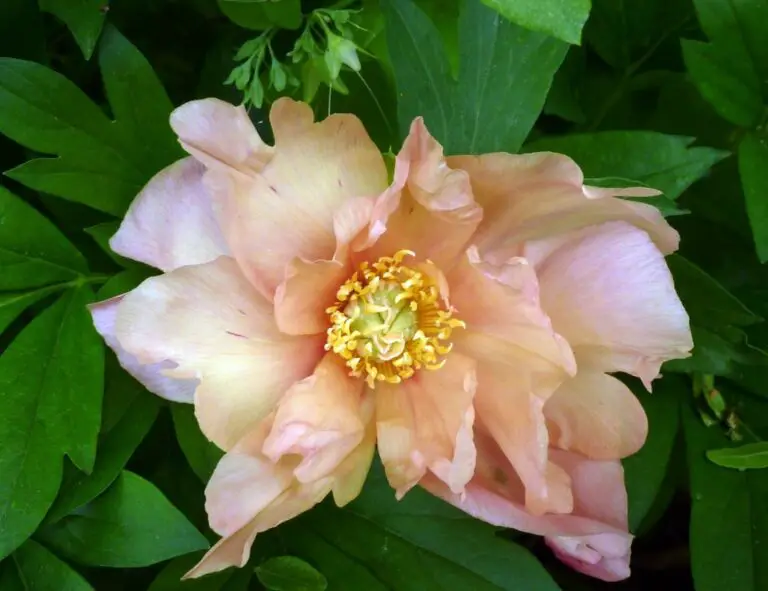18+ Best Drainage Ditch Landscaping Ideas
When rainwater accumulates in your yard, it can quickly become an unsightly issue. To prevent this from happening, you’ll need to think creatively about how to direct the water away from your outdoor space. The good news is that you can seamlessly integrate a drainage ditch into your landscape design. To get started, here are some innovative ideas for incorporating a drainage ditch into your yard’s aesthetic.
By using natural materials like rocks and gravel, or even creating a rock wall or water feature, you can turn what was once an eyesore into a beautiful and functional addition to your outdoor space.
18 drainage ditch landscaping ideas
To create a beautiful and functional drainage ditch landscape, follow these 18 straightforward tips for inspiration. A well-designed drainage system is crucial for maintaining a lush and healthy outdoor space, especially in areas prone to heavy rainfall or flooding. By incorporating these ideas into your design, you can turn what might seem like an ordinary drainage ditch into a stunning focal point in your garden.
For example, consider adding ornamental plants, water features, or even a small pond to create a visually appealing and functional area.
1-4. Rock ditch landscaping
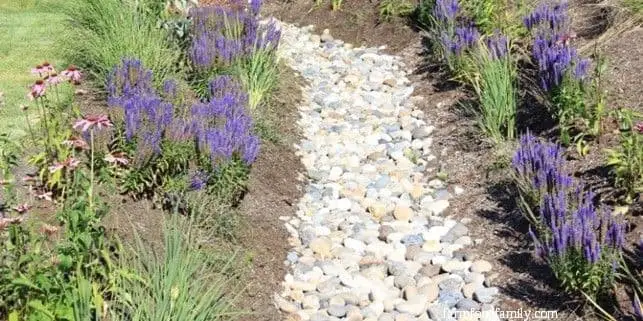

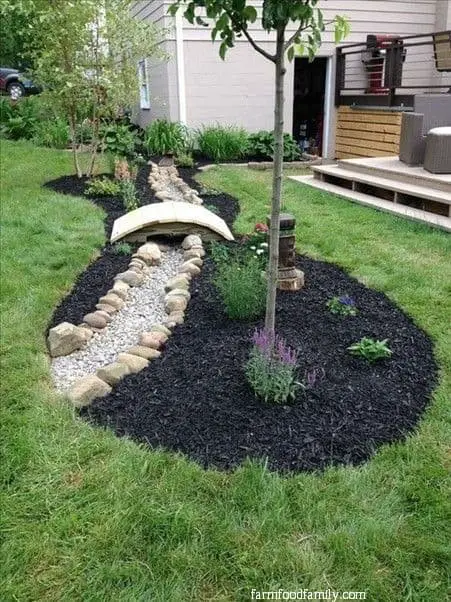
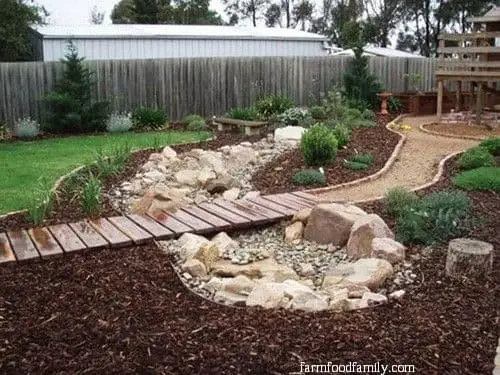
For a low-maintenance and budget-friendly drainage solution, consider incorporating a decorative rock drainage ditch into your landscaping design. A dry creek bed is an ideal option for directing water from your gutter to a turf and gravel bed landscape, while a flowing creek can add visual interest and movement to your yard.
To create a visually appealing design, use river rocks or smoother pebbles and stones in a creative arrangement that flows towards a streambank or incorporates ornate and dense patterns. Alternatively, you can build a dry creek bed that spans the entire yard, incorporating a mix of materials like rocks, pebbles, mulches, and wood elements to create a unique and eye-catching landscape feature.
5-6. French drain

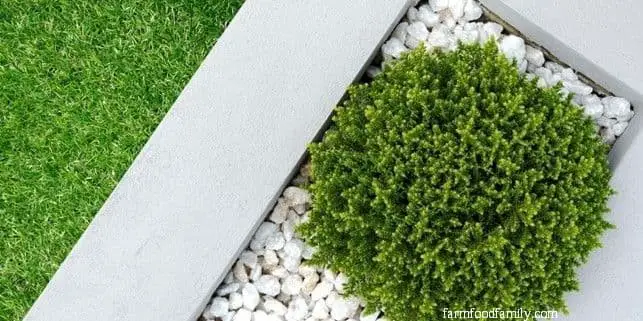
To achieve a sophisticated landscape appearance, consider installing a French drain that incorporates decorative elements. These systems often feature refined edging options such as brick pavers, concrete slabs, or other materials that complement the surrounding environment. For instance, this design combines neutral-toned quartz with brick stone edging, effectively creating a visual boundary between the turf and lush vegetation.
For a sleeker, modern aesthetic, consider pairing your drainage ditch with concrete edging and topping it off with white quartz for a polished finish.
Rock wall

For drainage ditches situated at the terminus of a driveway, this approach would be particularly effective. The impermeability of rocks makes them ideal for bolstering outdoor water currents during storm events, and they’re essential for maintaining free-flowing waterways. Typically, these rock walls serve as a conduit for primary pipes that originate from the roadside and terminate at a property line.
To add aesthetic appeal, a stone bed is often installed to create a visually appealing landscape feature.
8-11. Water feature
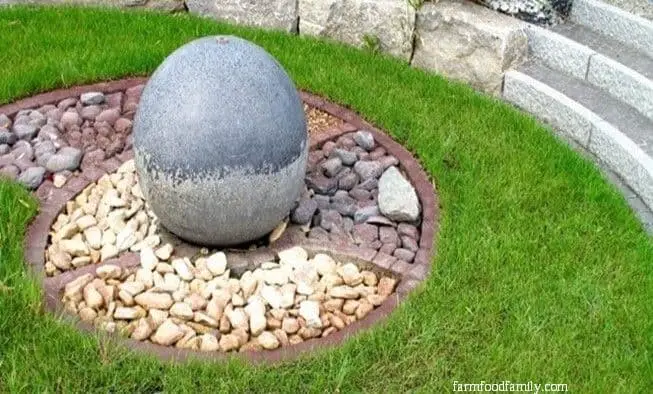
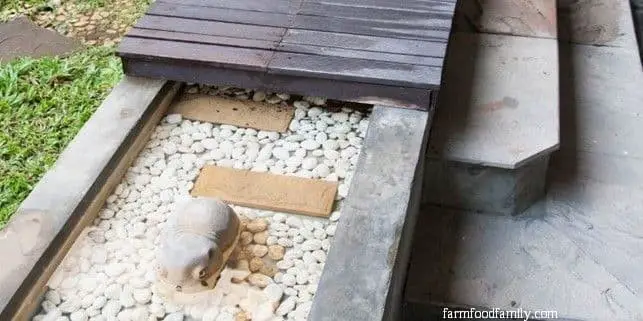
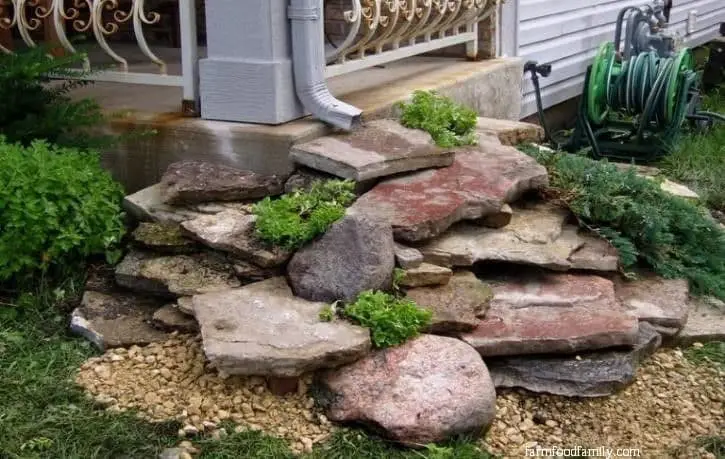
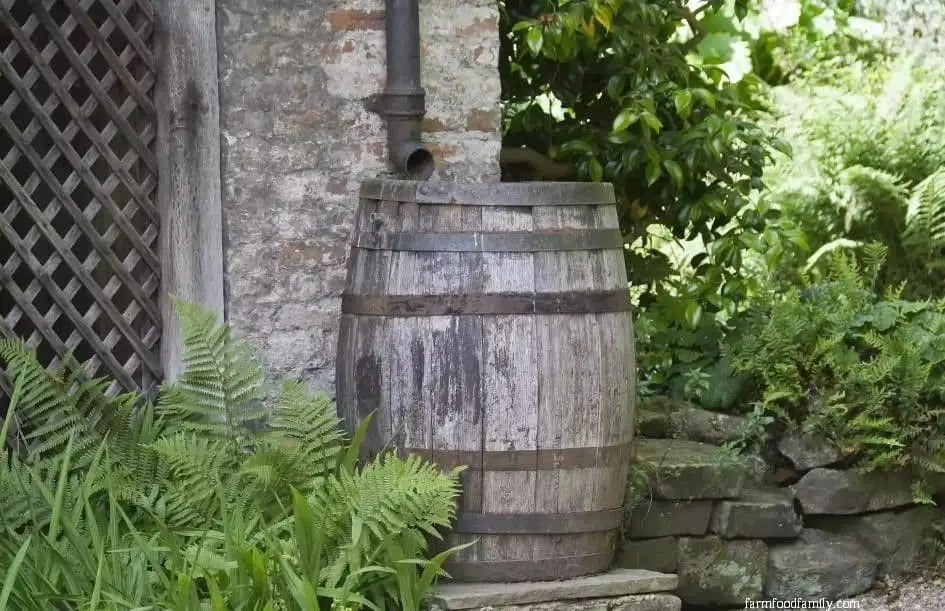
Transform your drainage ditch into a unique water feature that harmonizes with your landscape. Identify the area that collects the most water and create a central fountain system, where excess water can be recycled and reused. For a more serene atmosphere, encase the feature in wooden retractable covers, add light-colored pebbles to the pool, and surround it with a concrete frame, like a zen oasis.
Alternatively, you can turn your drainage ditch into a fountain by placing rough-edged concrete pavers at the end of the gutter pipe or strategically positioning a rain barrel just below the gutter, creating a seamless connection with your landscape’s aesthetic.
12-15. Drainage grates
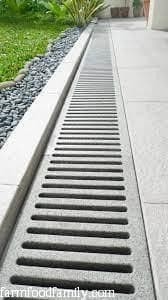
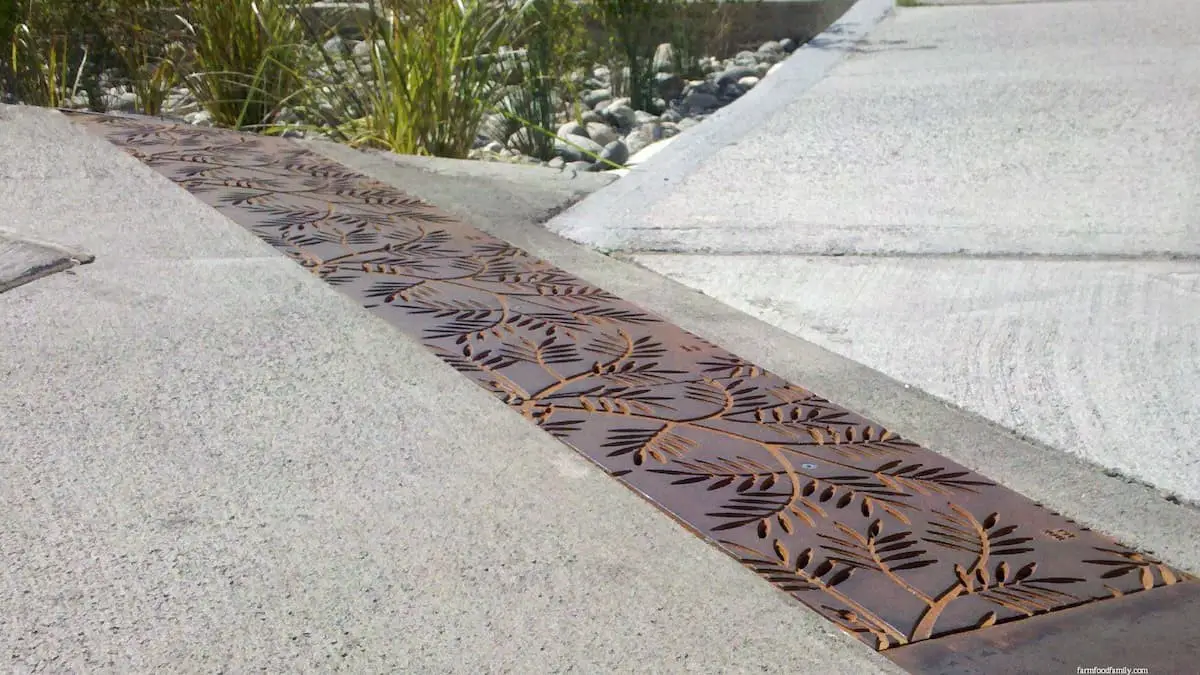
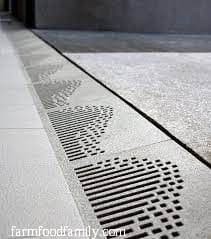
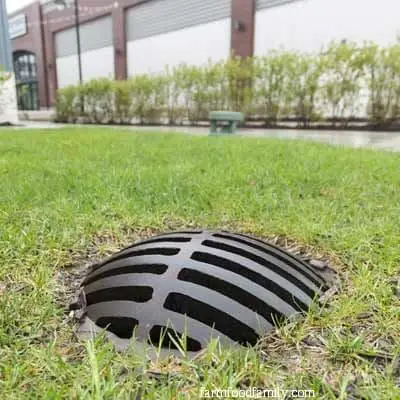
To effectively manage water runoff, consider installing a drainage grate system around your property or even inside your home. This can be achieved through the use of standard slatted gratings or more visually appealing decorative options. For a sleek and symmetrical look, you may opt for traditional gratings. Alternatively, you could choose from a variety of decorative trench grates or even a dome-like design that efficiently directs water into a single collection point.
16-17. Using paving materials
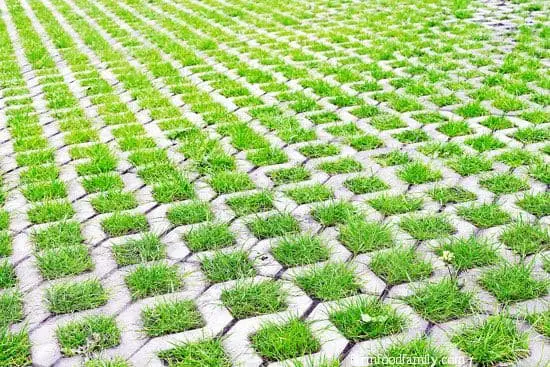
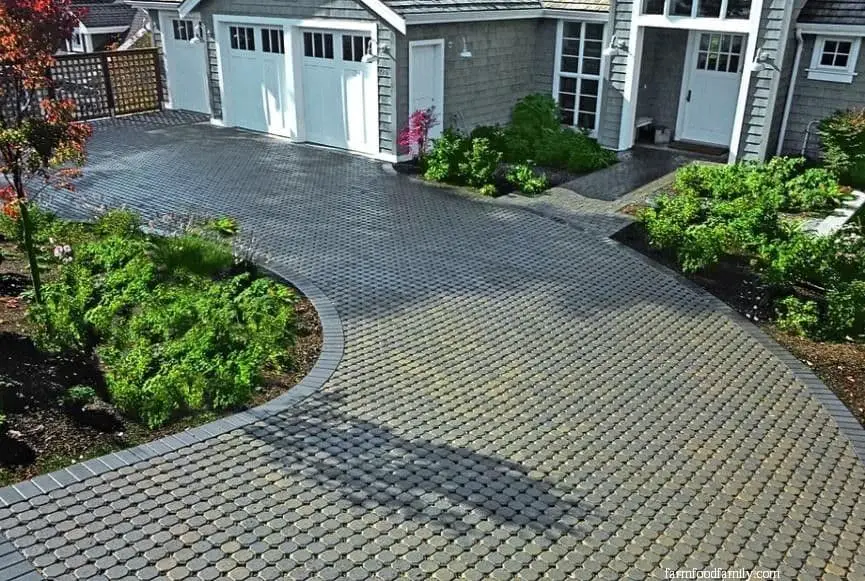
To create an effective drainage system in your landscape, consider incorporating small gaps between pavers, allowing excess water to flow freely. You can further enhance this design by incorporating grassy areas or other porous materials that promote water absorption. This type of paving not only helps prevent puddling but also adds a touch of curb appeal to your outdoor space.
Rain gardens

For sloping terrains, consider creating a raised rain garden that serves as a shallow catch basin for rainwater. This design requires fast-draining soils and a simple installation process involving a pipe or swale to manage water runoff. A typical raised rain garden setup is characterized by its straightforward layout, making it an accessible solution for homeowners seeking to mitigate stormwater issues.
FAQs
In addition to the creative drainage ditch landscaping ideas presented earlier, it’s equally important to consider the following frequently asked questions and their corresponding answers.
What should I line a drainage ditch with?
When it comes to drainage liners, there’s a diverse range of options available. While each type has its unique characteristics, some of the most prevalent ones include natural clay liners, spray and rock liners, pre-formed concrete liners, pre-formed plastic liners, as well as flexible polymer liners.
How do you keep a drainage ditch from washing out?
To effectively manage drainage and mitigate erosion, consider implementing the following strategies: Implement rock weirs or dam-like structures to deliberately slow the pace of water flow. This will help redirect water currents and prevent excessive erosion. Additionally, install grade stabilization structures that can re-route water flows, ensuring a more controlled and sustainable drainage system.
Finally, initiate revegetation efforts by seeding, installing streamside fencing, and planting rootstocks. These combined approaches will help to restore the natural balance of your area’s hydrological processes.
How much does it cost to put drainage in a yard?
The estimated cost of installing a drainage ditch in your yard can vary significantly, ranging from $1,200 to $8,000 overall, or $8 to $15 per linear foot, depending on the size of your lawn. Additionally, the type of materials used for installation also plays a crucial role in determining the final cost.
What is the best rock for drainage?
The coarse washed rock in question would likely measure ½ to ¾ inches in size, resulting in a uniform texture that’s easily distinguishable from finer materials. In contrast, pea gravels often exhibit a tendency to clump together, which may hinder their ability to move with water flow. This characteristic can have unintended consequences, such as clogging drainage pathways and impeding the free flow of liquid.
How deep does a drainage ditch need to be?
A typical recommendation for drainage ditch depth is 18 inches, allowing for ample space to create a gravel bed and accommodate the covered pipe above. This increased depth not only facilitates efficient water flow but also enhances overall landscape manageability.
Conclusion
When it comes to installing a drainage ditch as part of your landscaping, you’re not just solving a practical problem like water puddling and erosion – you’re also creating a visually appealing feature that can seamlessly integrate with your nearby pond or stream. Whether you’re opting for a rustic dry creek bed or a more sophisticated design, a well-executed drainage ditch can be a stunning addition to your lawn.
Related Posts
To ensure your farm business thrives, selecting the right equipment is crucial. It’s not just about investing in any old machinery; you need to choose tools that will streamline processes, boost productivity, and ultimately drive profits. This decision-making process requires careful consideration of several factors. First, assess your specific needs and goals. What are your farm’s unique requirements? Do you require heavy-duty equipment for plowing or lighter machines for planting seeds?
Next, evaluate the quality and reliability of potential equipment options. Research manufacturers, read reviews, and consult with industry experts to determine which brands offer durable, well-maintained products. Additionally, consider factors like maintenance costs, energy efficiency, and environmental impact. By taking a thoughtful approach to selecting farm equipment, you’ll be well on your way to establishing a strong foundation for long-term success.
This same level of consideration is necessary when choosing home services professionals. When it comes to tasks like driveway sealing, do you know how much to tip the workers? Understanding the etiquette surrounding gratuities can help ensure that your service providers are compensated fairly and that you’re not inadvertently causing offense. By learning about tipping norms for different industries, you’ll be better equipped to navigate these situations with confidence.
In other careers, like landscape architecture or design, a strong foundation in art and science is essential. These professionals must have a deep understanding of both the creative and technical aspects of their work. With dedication and hard work, individuals can build successful careers as landscape architects or designers. Similarly, garden photographers require a unique blend of artistic vision and photographic expertise to capture stunning images of flora and fauna.

